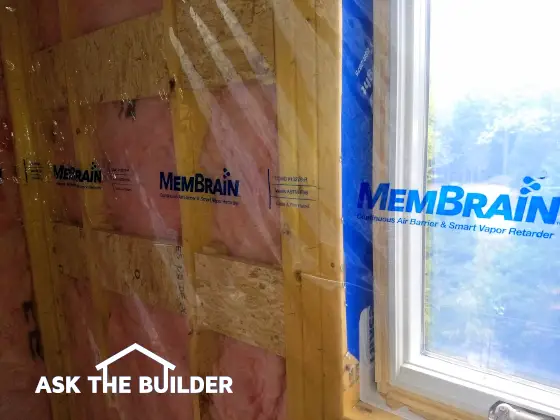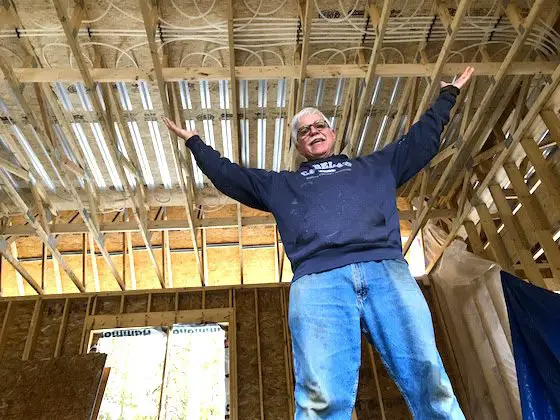Insulation Installation

Insulation installation | You need to read the written instructions. This is a modern vapor retarder - Certainteed MemBrain - but some contractors don’t believe in them for a host of reasons. (C) Copyright 2019 Tim Carter
"The same exact thing can happen inside a wall cavity in a home in a frigid climate if you don't block and stop the water vapor from getting into the wall cavity."
Insulation Installation - Simple If You Read Instructions
The inspiration for this column happened just two days ago while I was working on my daughter and son-in-law’s new home up in Downeast Maine. It’s important to realize I’m not the builder but act as their primary advisor, the plumber, electrician, and radiant heat installer.
My son-in-law and I arrived at the house to work about 7:00 AM and at 8:30 AM a medium-sized box truck pulled onto the lot along with a pickup truck. Five workers tumbled out of both vehicles and they started to put in fiberglass insulation up under all the floors in the house.
With the help of my son-in-law, a month or so ago we had installed 900 Uponor heat transfer plates and 6,000 feet of Uponor hePEX tubing that will keep my daughter, son-in-law and new granddaughter warm as bugs in a rug.

This is the Uponor hePEX that we installed under the floor of the future office/guest bedroom suite above the garage. It's not easy to install it three rows of heat transfer plates per truss bay. CLICK or TAP HERE to watch a video showing how it's done.
Who Is A Leader in Radiant Heat Products?
Uponor happens to be one of the leaders in radiant heat products and technology. Read the beginning pages of their installation manual about the simple science behind radiant heat and you’ll be amazed.
The middle-aged leader of the insulating crew, let’s imagine his name is Sebastian (it’s not), and I got into a friendly discussion about exactly how the insulation batts should be installed. Sebastian asked me, “Do you want a 1 or 2-inch airspace between the insulation and your PEX tubing?”
“I don’t want any airspace. The Uponor installation manual says to put the insulation in direct contact with the tubing.” I replied.
“Well, my entire career we’ve always installed the insulation with an airspace. That’s the way to do it.” Sebastian countered.
“That’s very interesting, Sebastian. Since heat travels directly to cold, you want the insulation to be in contact with the heat pipes. This forces the heat upwards into the floor. If what you suggest is the right way to do it, why are you filling the wall cavities all the way with your fluffy insulation? Why not leave an airspace between the back of the drywall and the batt?”
Doing Things Wrong For Twenty Years
I said the above as respectfully as possible because most older people don’t like to be challenged or have their intelligence questioned. I could tell the gears up in his head were spinning. We then had a quick discussion about the new high-performance vapor retarder my son-in-law and I were installing over his insulation. Once again, his lack of scientific critical thinking soon bubbled to the surface.
Downeast Maine can get darn cold in the winter. This past winter I was working in the house installing cast iron drain pipes and it was 2 F in the house. Sebastian had never thought about the condensation that forms on the outside of his cold can of beer while sitting on his deck after work.
You can watch a funny outake insulation video here.
The same exact thing can happen inside a wall cavity in a home in a frigid climate if you don't block and stop the water vapor from getting into the wall cavity.
The water vapor that’s in the warm air inside a house can easily travel through drywall and fiberglass on its way to the outdoors. When this vapor contacts the cold exterior wall sheathing, it transforms to liquid water just as the droplets of water form on your soda can, beer can, or glass of iced tea on a humid day.
Should You Install a Vapor Barrier?
Watch this video and decide for yourself, then read about Sebastian.
When Sebastian first arrived he introduced himself to my son-in-law. At lunch that day, my son-in-law said to me, “Tim, guess what? Sebastian came up to me a couple of hours after talking with you and out of the blue said, ‘I just discovered I’ve been doing things wrong for my entire career.’ "
Do Egos Get in The Way?
I’ve had similar conversations with other contractors and sub-contractors for years, but Sebastian was the first one that admitted he was wrong. You should realize that a strong ego is highly recommended if you want to survive in the residential construction industry. But you can temper it with an open mind and the desire to apply simple science to the building process.
One of my biggest complaints about the construction industry, as a whole, is there’s no formal education required to get into the game. Think about it. You can go to a big box store just after reading this column of mine and buy a ladder, a tool belt, a hammer, tape measure, and razor knife and be a roofer by noon. Yet, you’ve never been trained on how to install a roof. You’ve never read the written instructions that are out there. However, my guess is you can get a customer or two to hire you to re-roof their home.
STOP Trusting Contractors
What does this have to do with you and your hard-earned money? You need to stop trusting all contractors. You need to STOP assuming they’re always doing things the right way. You need to stop assuming they’re always thinking of your best interests.
You need to start doing one simple thing to protect your home and your investment. You need to select the products you want to use for your next project, your next remodeling adventure, or your next new home. Then you must take the time to READ the written installation manuals or watch the manufacturer’s installation videos online.
You need to do this before you hire a contractor not after when things go wrong. Ask her/him exactly how they intend to do the job. See if they’ve been doing it wrong their entire career.
Yes, this is work. Yes, this conversation with the contractor is not comfortable. But what the heck, it’s only your money so what’s the big deal, right?
Column 1305
18 Responses to Insulation Installation